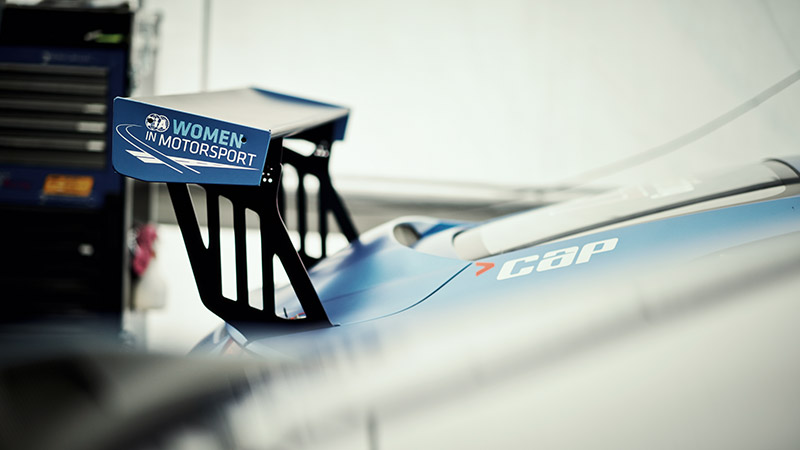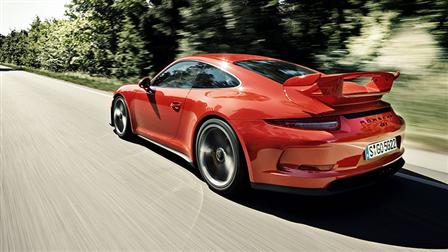Where does a race car begin, where does the street-legal version end? When it comes to the current 911 GT3, the first segues seamlessly into the second, says Danish
In terms of personality, Michelle Sophie Gatting and the
But watch out, world, when they let go. Because Michelle Gatting is a professional race-car driver. The 20-year-old not only battles the big guys on the racetrack. Her hobbies include fitness, boxing, and CrossFit workouts (which the U.S. Army uses to keep its troops-in-fighting trim). “Yeah,” says the Dane in her deep voice, “I’ve always been a tough girl. I race, I enjoy boxing.” And the 911 GT3? Why, it’s the most extreme representative of its kind. Every
The two 911 brothers meet in Nuremberg. The occasion: a
She’s equally at home sitting behind the wheel of the Cup race car or the street-legal version. “My boyfriend is from a
Gallery
Michelle Gatting slides her 5'11" frame into the bucket seat of the 911 as though it were a custom-fit tube dress. “The seat is just like a real racing bucket seat, but still comfortable,” she says. Thanks to the long thigh support, there is even sufficient grip for her legs. Before heading off to the racetrack, she purposefully presses the Sport exhaust button: “That makes the engine sound even more like a race car!”
If you want to feel something, you should hear it as well. No sooner has she fastened her seat belt than she reaches for the paddle shifts on the steering wheel. Changing gears like this is second nature to her. The Cup vehicle based on the 991 model generation also has these paddles on the steering wheel. “I always get that race-car feeling when I sit in a street-legal car with my fingers on the paddle shifts,” says Gatting. But that great feeling is underscored by technical aspects: “The PDK transmission is just plain awesome.”
The 911 GT3 features a radically overhauled


For the drive through town, Gatting selects the Automatic option and serenely rolls through the heavy traffic, although she herself seems increasingly restless. “I confess that it’s really hard for me to drive so slowly in a car like this,” she says with a sigh. “I really think it’s great that the 911 GT3 is so perfect for everyday situations and that you can use it to just cruise through town. But for me personally, I’d rather be on the highway or at the racetrack.” This native of Denmark is not the only one who needs to experience this super athlete at the limit, to tease out the maximum performance, to see how far she can go. Around 80 percent of all 911 GT3s sold are driven on racetracks, as well. That is where the dynamic handling of the

Having arrived at the temporary Norisring city racecourse, Gatting vanishes into the truck of her Attempto team. Out of her leisure apparel, into her racing overalls. The 911 Cup, number 77, is waiting in the team tent. Her race car. It is strikingly similar to the bright red 911 GT3 that she has just parked. If you disregard the colorful sponsor stickers, the most visible difference is the significantly higher rear wing on the Cup car. But Michelle thinks a generalization is in order here: “They’re the same cars, no question about it.”
There are, of course, further differences between the street-legal and the racing version. This becomes crystal clear when you take a look at the cockpit. In the street-legal version, black Alcantara®, brushed aluminum, and leather create an ambience at once elegant and sporty. In contrast, the interior of the 911 Cup was pretty much cleared out. Only the racing bucket seat with six-point seat belts, a fire extinguisher, and the safety cage remain. The interior is unquestionably austere. The significantly smaller steering wheel is adorned with a number of colorful buttons, but in a nod to brotherhood, the rim is covered by black Alcantara®.
There was a reason for this crash diet: weight. And yet, at 3,152 pounds (empty), the street-legal GT3 is already a lightweight. But the racing version weighs a mere 2,590 pounds, a full 562 pounds lighter. Soundproofing was also sacrificed in the name of weight reduction. Loud? Naaaah. Gatting enjoys the soundscape: “This way, you hear the boxer engine even better.” It’s music to race by. She also gets a quiet kick out of seeing what happens when a layperson opens the driver’s door on the Cup—and gets a fright. “The door is made of carbon, so light that people practically tear it off when they swing it open in the usual way.” Lightweight construction was specified for the street-legal 911 GT3 as well. Those red doors are made of aluminum and thus they, too, weigh very little.
Some stretches of the city racecourse have already been blocked off, allowing Gatting to step on the gas in her street-legal 911—for the perfect comparison, as it were. The
The

In a race, Gatting has to forgo most of the electronic support with which the street-legal version pampers its drivers. No ABS, no PSM (
By Eva-Maria Burkhardt
Photos by Victor Jon Goico









